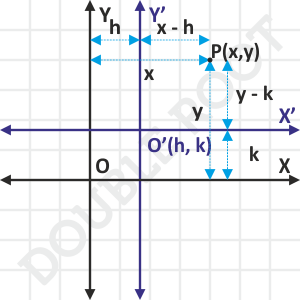In this lesson, we’ll discuss something known as translation of axes or shifting of origin.
Shifting of Origin / Translation of Axes
What we’re trying to do here is shift the origin to a different point (without changing the orientation of the axes), and see what happens to the coordinates of a given point.
See the figure below to get an idea of what we’ll be doing.

But why are we doing that?
Well, for the moment, you’ll have to believe me that shifting of origin leads to simplification of many problems in coordinate geometry. But it’ll make sense to you only when you see it in action in subsequent chapters, especially conic sections. For now, let’s just focus on how shifting of origin works, and how to apply it to problems.
Consider a point P(x, y), and let’s suppose the origin has been shifted to a new point, say (h, k). What will be the coordinates of the point P, with respect to this new origin?
Recall that the coordinates of a point are it’s (signed) distances from the coordinate axes. So, to find the coordinates of the point P(x, y), we have to find its distances from the shifted coordinate axes. Turns out this is quite easy to find. Have a look at the figure below.

The shifted origin has the coordinates (h, k). That is, the shifted X and Y axes are at distances h and k from the original X and Y axes respectively.
Therefore, the distance of the point P from the new X-axis will be x – h and from the shifted Y-axis will be y – k. This means that the coordinates of the point P will be (x – h, y – k).
Here’s a simulation that demonstrates the shifting of origin. You can drag O’ and observe how the coordinates of A change.
And that’s all there is to it. To conclude, if (X, Y) be the coordinates of the point with respect to the new origin (h, k), then
X = x – h
Y = y – k
Or,
x = X + h
y = Y + k
These will be the very substitutions which you’ll make when finding equations of a curve with respect to shifted axes. Don’t worry about this now, we’ll come to that later on.
Lesson Summary
If (x, y) are the coordinates of a point, and the origin is shifted to (h, k), without changing the orientation of the axes, then the new coordinates (X, Y) of the point will be given by x = X + h and y = Y + k.
In the next lesson, we’ll discuss the rotation of axes, and then move on to examples on both.